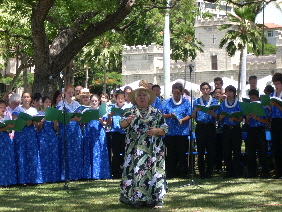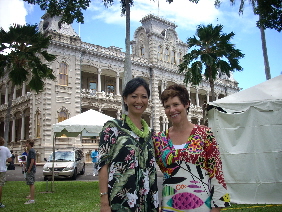Singing with the choir
Early on in my search to understand the last queen of Hawai‘i, I met with Corinne Chun Fujimoto, curator of Washington Place, the gracious, white-columned home in downtown Honolulu where Queen Lili‘uokalanis had spent the last years of her life.
Corinne suggested that the best place to look for the queen was not through the places she lived, nor even through the words she wrote in official documents, diaries or correspondence, but in Lili‘uokalani’s music. So I began with The Queen’s Songbook, a monumental, decades-long effort to collect and publish the queen’s compositions. The task began in 1969 and took more than twenty-five years to come to fruition.
The Songbook was based on a collection that the queen herself had hoped to publish in the late 1890s but never did: “He Buke Mele Hawaii: Hawaiian Songs with Words and Music.” For a century or so, the manuscript had been tucked away in the state archives.
One of the many, many people who contributed to The Queen’s Songbook was Nola A. Nāhulu, who now directs the choir at Kawaiaha‘o Church. “Auntie Nola,” as some of the younger choristers call her, holds a storied position: Lili‘uokalani herself directed the same choir a century earlier and loved playing the church’s great pipe organ.

Nola A. Nāhulu, director of the Kawaiaha'o Church choir and the Hawaii Youth Opera Chorus, leads choristers in an outdoor performance at 'Iolani Palace.
So it was with delight and some trepidation that I accepted an invitation to sing with the choir at a Sunday service, directed by “Auntie Nola.” I sang with the soprano choristers, who wore formal mu’mu’u dresses in a pattern of green, black and white brightened with sprays of delicate orchid blossoms. Green silk lei hung around their necks.
We sat together in the first floor choir stall, at the back of the church looking over the congregation. Singing directly in front of me was Malia Ka‘ai-Barrett, who works alongside Nola as general manager of the Hawai i Youth Opera Chorus. Although I can sight-read and I sing with my own church chorus at St. John’s Episcopal Church in Ross, California, I was relieved to follow Malia through the hymns we sang in Hawaiian.
Behind us was the massive pipe organ, played by Richard “Buddy” Naluai. As one of the first Christian churches in the islands, made of thousand-pound blocks of coral stone cut and then dragged from the sea, the building is on the Registry of National Historic Places.
Kawaiaha‘o was the church for Hawai‘i’s ali‘i – its chiefs – and I sat almost at eye level with the powerful portraits of the kingdom’s rulers that hung on the walls. The sermon by Kahu (Reverend) Curt Kekuna started off with the question: “Why are you here?” and went on to preach, “We’re not here to create another Christian country club … we’re here to go out and transform the world!”
Why was I here? I’d been invited to join the choir Claire Hiwahiwa Steele, whom I’d met in a Hawaiian studies class at the University of Hawaii at Mānoa earlier in the week. Claire is not only a member of the choir but also the church’s newest trustee. A graduate of Kamehameha Schools, she is a recipient of a church scholarship that’s allowed her to pursue a master’s degree at UHM.
I couldn’t pass up the opportunity to sing the queen’s songs in her own church with people who’d grown up with her music . And the experience profoundly moving — joining together with these beautiful voices to perform the queen’s own songs. It touched me in a way that no amount of reading or writing ever could.
Yet , I was also there as an author and journalist: I couldn’t resist pulling out my reporter’s notebook during the service. Or, for that might, smiling with recognition when I spotted choristers tapping away on iPhones and Blackberries while I was scribbling in my pad. Good thing Auntie Nola didn’t catch us!

What is Claire studying at the University of Hawaii at Mānoa, and how is she funding it?